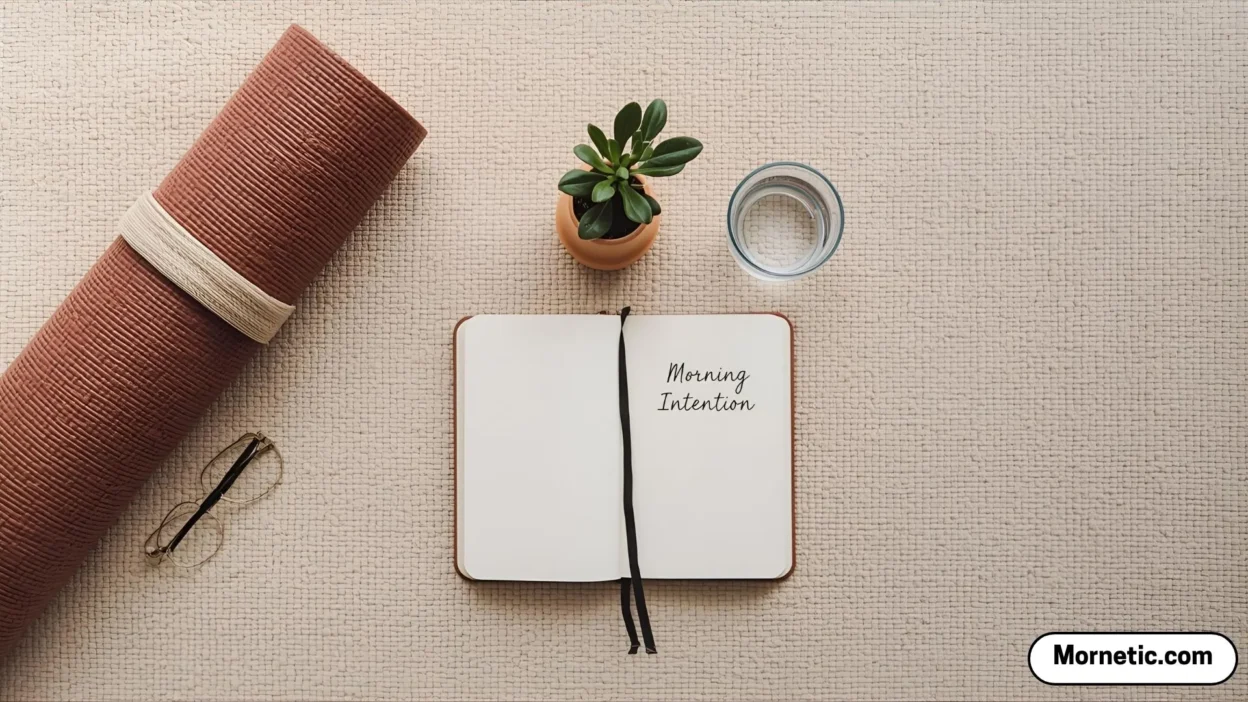Waking up feeling stiff, sore, or just plain groggy is a common experience for many of us. The allure of the snooze button is powerful, but what if a simple 10-15 minute routine could transform your entire day? Enter morning yoga stretches. This isn’t about achieving complex poses; it’s a gentle, systematic way to wake up your body, calm your mind, and set a positive, productive tone for the hours ahead. By mobilizing your spine, stimulating circulation, and releasing muscular tension, a morning yoga sequence is the ultimate tool for combating the sedentary nature of modern life. This guide will walk you through a complete routine, explain the science behind the benefits, and provide tips to make your morning practice a lasting habit.
Why a Morning Yoga Routine is a Non-Negotiable for Your Health
Starting your day with movement sends a powerful signal to your body and brain that it’s time to wake up and engage with the world. Unlike a frantic rush to check emails, yoga provides a centered, intentional beginning.
- 🧠 Boosts Mental Clarity & Focus: Yoga combines movement with breathwork, increasing oxygen flow to the brain. This helps dissolve morning brain fog and sharpens your concentration for the day’s tasks.
- 💪 Improves Flexibility & Mobility: After a night of stillness, your muscles are at their coldest and stiffest. Gentle stretching in the morning gradually increases your range of motion, making daily movements easier and reducing injury risk.
- 😌 Reduces Stress & Anxiety: By activating the parasympathetic nervous system (the “rest and digest” mode), yoga lowers cortisol levels. This creates a buffer against the day’s inevitable stressors.
- 🔄 Enhances Circulation & Energy: The various poses encourage blood flow to your muscles, organs, and brain, effectively “waking up” your entire system far more effectively than a cup of coffee alone.
- 🎯 Sets a Positive Intentional Tone: Your morning often dictates the rhythm of your day. A yoga practice is a form of moving meditation that cultivates mindfulness and purpose.
What You Need to Begin Your Morning Stretch Practice
The beauty of morning yoga is its utter simplicity. You don’t need a dedicated studio or expensive equipment.
- A Yoga Mat: Any non-slip mat will provide comfort and stability for your joints.
- Comfortable Clothing: Wear something that allows you to move freely without restriction.
- A Quiet Space: Just enough room to stretch your arms and legs out fully—a corner of your bedroom or living room is perfect.
- An Open Mind: Let go of expectations. Some days your body will feel more open than others; that’s perfectly normal.
The Foundational Breath: Awakening Your Body from Within
Before you move a single muscle, we start with the breath. Your breath is the remote control for your nervous system and the foundation of your entire practice.
- Sit comfortably on your mat or even on the edge of your bed.
- Close your eyes and place one hand on your belly and the other on your chest.
- Inhale deeply through your nose, feeling your belly expand like a balloon.
- Exhale slowly through your nose or mouth, feeling your belly gently draw in.
- Continue for 8-10 rounds, focusing solely on the sound and sensation of your breath.
Gentle Warm-Up Poses to Ease Into the Day
This initial phase is about building heat gradually and listening to your body’s morning signals.
1. Seated Neck and Shoulder Rolls
- Sit cross-legged. Inhale and slowly roll your right ear toward your right shoulder. Exhale and gently roll your chin to your chest, then to the left shoulder. Repeat 5 times each direction.
- Follow with shoulder rolls, lifting them up to your ears on an inhale, and rolling them back and down on an exhale. Repeat 8-10 times.
2. Seated Cat-Cow Stretch
- Come to a tabletop position on your hands and knees. As you inhale, drop your belly, lift your chin and tailbone (Cow Pose). As you exhale, round your spine, tuck your chin and tailbone (Cat Pose).
- Flow between these two shapes for 10-12 rounds, synchronizing each movement with your breath.
3. Child’s Pose
- From tabletop, sink back onto your heels and fold forward, resting your forehead on the mat and extending your arms forward.
- Breathe deeply into your back, feeling your spine lengthen. Hold for 8-10 breaths.
Standing Poses to Build Strength and Stability
These poses energize the legs, improve balance, and build foundational strength.
1. Mountain Pose (Tadasana)
- Stand tall with your feet hip-width apart. Ground down through all four corners of your feet.
- Engage your thighs, lengthen your tailbone down, and lift through the crown of your head.
- Relax your shoulders down your back and take 5-8 deep breaths here, finding stillness and alignment.
2. Forward Fold (Uttanasana)
- From Mountain Pose, exhale and hinge at your hips to fold forward. Bend your knees as much as needed.
- Let your head hang heavy and hold onto your elbows. This pose calms the brain and stretches the entire back body. Hold for 8-10 breaths.
3. Halfway Lift (Ardha Uttanasana)
- Place your hands on your shins and flatten your back, bringing your torso parallel to the floor.
- Inhale here to lengthen your spine. This is a great transition pose to build core strength.
4. Low Lunge (Anjaneyasana)
- Step your right foot back into a lunge, lowering your back knee to the mat. Keep your front knee over your ankle.
- Inhale and sweep your arms overhead, feeling a deep stretch through your hip flexors. Hold for 5-8 breaths, then switch sides.
Key Spinal Twists for Detoxification and Mobility
Twists are fantastic for morning practice as they wring out tension and stimulate digestion.
1. Seated Spinal Twist
- Sit with your legs extended. Cross your right foot over the outside of your left knee.
- Inhale to sit tall, and exhale to twist your torso toward your right thigh, using your left arm to hug your right knee.
- Hold for 5-8 breaths, then repeat on the other side.
2. Supine Spinal Twist
- Lie on your back. Hug your right knee into your chest, then guide it across your body toward the floor with your left hand.
- Extend your right arm out and gaze toward it. Feel the release in your lower back and hips. Hold for 10-12 deep breaths per side.
Hip-Opening Poses to Release Stored Tension
Our hips are a common storage unit for stress and tension, especially from prolonged sitting.
1. Pigeon Pose (Eka Pada Rajakapotasana)
- From Downward-Facing Dog, bring your right knee forward toward your right wrist, with your right ankle near your left wrist.
- Slide your left leg back and square your hips. Fold forward over your front leg for a deeper stretch. Hold for 10-15 breaths per side.
2. Bound Angle Pose (Baddha Konasana)
- Sit on the floor and bring the soles of your feet together, allowing your knees to fall out to the sides.
- Sit tall on your sitting bones. You can stay upright or gently fold forward. Hold for 1-2 minutes.
Inversion Poses to Change Your Perspective
Gentle inversions reverse blood flow, boosting circulation and mental alertness.
1. Legs-Up-The-Wall Pose (Viparita Karani)
- Sit sideways with your right hip close to a wall. Swing your legs up the wall as you lie back.
- Rest your arms by your sides, close your eyes, and breathe. This is profoundly restorative. Hold for 2-5 minutes.
2. Downward-Facing Dog (Adho Mukha Svanasana)
- From tabletop, tuck your toes and lift your hips up and back, forming an inverted “V” shape.
- Pedal out your feet, bending one knee and then the other. Hold for 5-8 breaths, rest in Child’s Pose, and repeat.
A Sample 15-Minute Morning Yoga Sequence You Can Do Daily
This is a practical, flow-ready sequence you can memorize and practice every morning.
- Minute 0-2: Foundational Belly Breathing
- Minute 2-4: Seated Cat-Cow (8 rounds)
- Minute 4-5: Child’s Pose (5 breaths)
- Minute 5-6: Mountain Pose (5 breaths)
- Minute 6-8: Forward Fold → Halfway Lift → Forward Fold (flow 3 times)
- Minute 8-10: Low Lunge (right side)
- Minute 10-12: Low Lunge (left side)
- Minute 12-13: Downward-Facing Dog (5 breaths)
- Minute 13-14: Seated Spinal Twist (right side)
- Minute 14-15: Seated Spinal Twist (left side)
- Minute 15: Savasana (1 minute of quiet rest)
How to Modify Your Morning Yoga Stretches for Your Body
Yoga is for every body. Honor yours by using props and making adjustments.
- For Tight Hamstrings: Bend your knees generously in all forward folds.
- For Wrist Pain: Perform planks and Downward Dog on your fists instead of flat palms.
- For Knee Sensitivity: Place a folded towel or blanket under your knees in kneeling poses.
- Use a Chair: Every seated pose can be done sitting in a chair for added stability and support.
Common Mistakes to Avoid in Your Morning Practice
Awareness of these pitfalls will make your practice safer and more effective.
- 🚫 Skipping the Warm-Up: Jumping straight into deep stretches is a recipe for injury.
- 🚫 Holding Your Breath: Your breath is your guide. If you’re holding it, you’re pushing too hard.
- 🚫 Comparing Yourself to Others: Your practice is personal. Focus on how you feel, not how you look.
- 🚫 Forcing a Pose: Discomfort is okay; sharp pain is not. Always back off and modify.
Integrating Mindfulness and Intention into Your Routine
Transform your physical routine into a moving meditation.
- Set an Intention: Before you start, set a simple intention for your day—like “patience,” “grace,” or “curiosity.”
- Practice Mindful Awareness: Notice the sensations in your body without judgment—the stretch, the warmth, the slight tremble.
- Express Gratitude: As you finish, take a moment to thank your body for its strength and your mind for its focus.
Frequently Asked Questions About Morning Yoga Stretches
Q: How long should my morning yoga session be? A: Even 5-10 minutes is beneficial! The key is consistency. A 15-20 minute routine is ideal for a comprehensive stretch.
Q: Should I do yoga before or after breakfast? A: It’s generally recommended to practice on an empty stomach, or after a very light snack like a few sips of water or a piece of fruit. This allows for deeper twists and more comfortable forward folds.
Q: I’m not flexible at all. Can I still do yoga? A: Absolutely! Yoga is not about being flexible; it’s about becoming flexible. The poses are tools to help you gain mobility, and modifications make them accessible to everyone.
Q: What’s the difference between yoga and just stretching? A: While both involve stretching, yoga is a holistic practice that integrates breath control (pranayama), meditation, and mindful intention with physical movement. It’s a mind-body practice, not just a physical one.
Conclusion
Establishing a routine of morning yoga stretches is one of the most impactful habits you can cultivate for your long-term physical and mental well-being. It requires minimal time and equipment but offers maximum returns in energy, clarity, and resilience. This guide provides everything you need to build a practice that fits your life and addresses the unique needs of your body. Remember, the most perfect pose is the one that you do. So, unroll your mat tomorrow morning, take a deep breath, and give yourself the gift of a centered, energized start. Your future self will thank you for it.

Grace is a lifestyle writer from California who loves starting mornings with positivity. At Mornetic, she shares uplifting quotes and cheerful messages to brighten your day.




